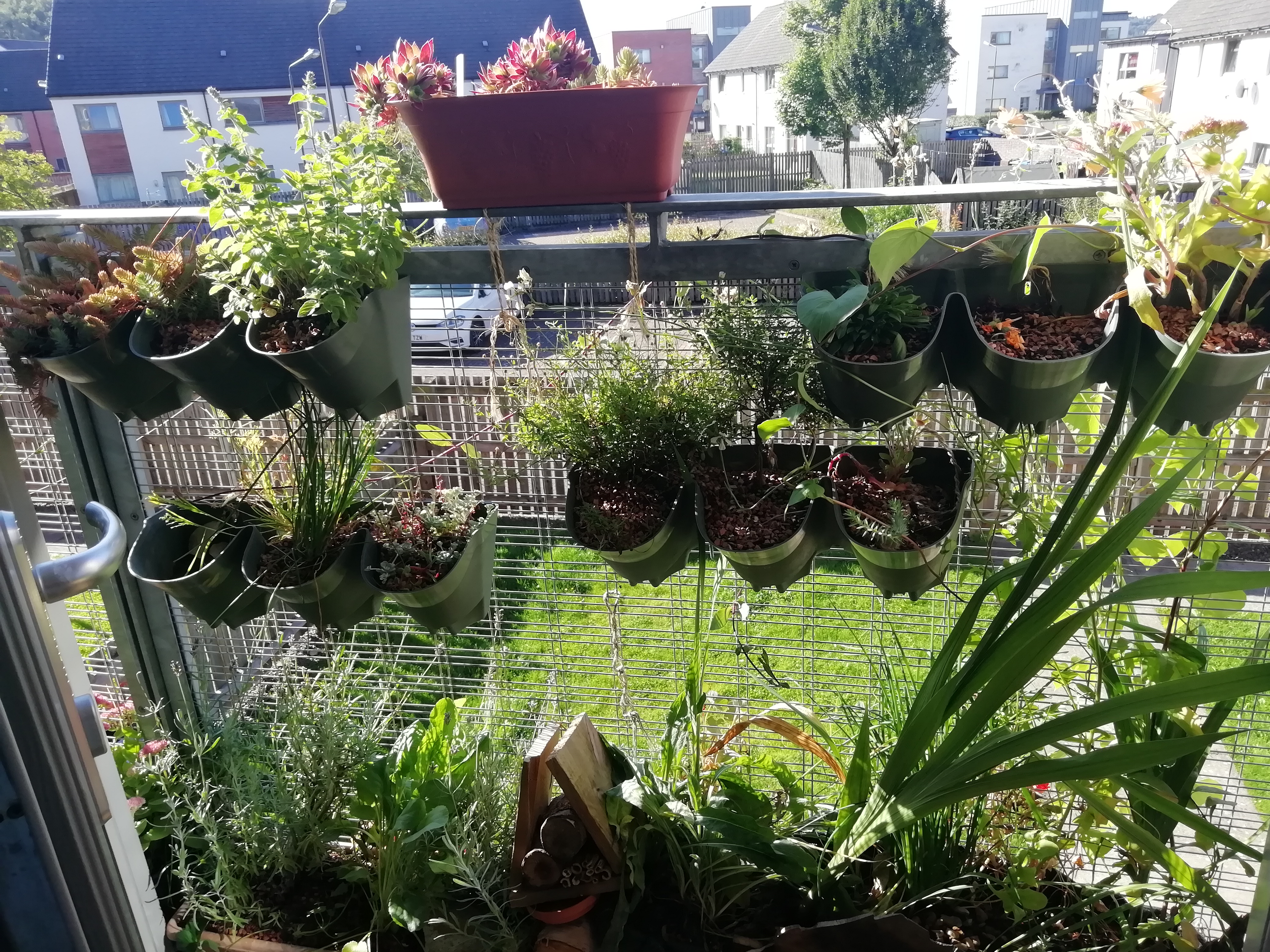If I ever wonder whether my small efforts to help insects in my garden are worth it, all I need to do is have a look and listen to the life of the balcony garden of my first-floor flat in the Scottish city of Stirling.
The ground dimensions are roughly 15 centimeters by 2 meters – a mere 0.3 square meters! So it’s the smallest garden I’ve ever had, but I think I’ve made the best of it by seeking inspiration from natural habitats and choosing plants that are insect-friendly and hardy enough to survive on limited soil and periods when I may be away for a week or two and can’t water them.
Here’s what I did…
Ground layer:
This is my forest floor, where the soil should be deep and cool. To achieve that I got the tallest planters I could find that would fit into the 15cm wedge, and I put tiny holes in the bottom to ensure that some water could still drain off, but only slowly. Drainage is important as I don’t want the planters to become flooded in winter. I filled them with peat-free compost, and placed them on planter trays to catch any draining water so that the water wouldn’t drain onto my neighbours below.
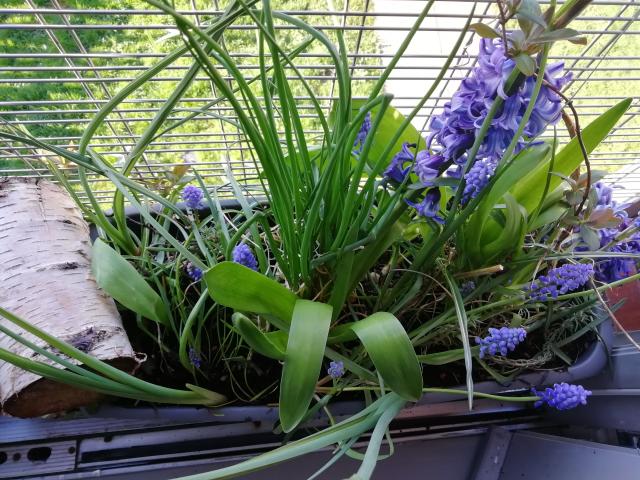
In one of them I really embraced the forest floor theme, and planted it up with bulbs, including muscari (grape hyacinth), hyacinth, Iris and crocus. I also transplanted some chives from another garden. These all stay low to the surface and their leaves shade the soil from sun – this is important as the balcony faces south and gets full sun almost all day in summer and could quickly dry out. In this layer I also have a honeysuckle which vines through the trellis and gives a nice year-round structure. Each year now I also grow Nasturtiums from seed and plant them in this one – their long stems can crawl up the trellis then trail out over it. Nasturtiums are one of the most useful plants for insects as bumblebees can get nectar and pollen from the large colourful flowers, and Small and Large White butterfly caterpillars can eat the leaves – I have found them feeding on these balcony plants, so this definitely works! I grow rocket from seed too, and it does extremely well in this planter. It provides me with salad leaves, while making large creamy white flowers on long stalks that poke through the trellis and attract insects.
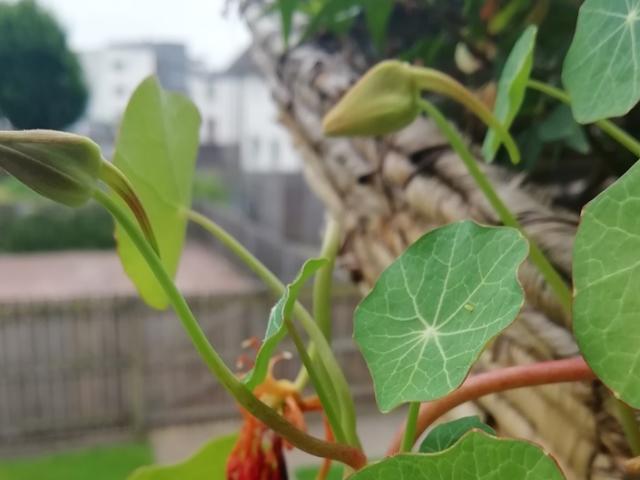
In the other planter I decided to go for more drought-tolerant plants that wouldn’t need so much water. These include lavender, rosemary and sea holly (eryngium), and this year I bought some annual Bidens plants from the garden centre – Bidens have small bright yellow flowers that will trail over the balcony, and as they grow well in hanging baskets I know they’ll be fine here.
Growing up
To make the best of the limited space, I had to start planting vertically. I found planters designed just for this purpose, but I had to adapt them: the normal way to use them is to drill a hole into a wall and screw them in – but I had no wall! So I got extra strong garden twine, and tied them to the trellis. Each compartment is fairly small so I knew that for this layer I needed to find the hardiest plants that could deal with drought and constant exposure to sun, but still be attractive to insects. So in this area I have two types of Sedum (including Sedum ‘Autumn Joy’ which flowers in late summer), Mexican Daisy (Erigeron), Cape Daisy (Osteospermum), and alpine Dianthus which would normally be found on exposed mountainsides in poor soil, and lemon thyme. Lemon thyme is one of my favourite herbs to cook with, some having a constant supply of it to hand is a great bonus. In summer it is covered in tiny flowers that are attractive to all kinds of pollinating insects.
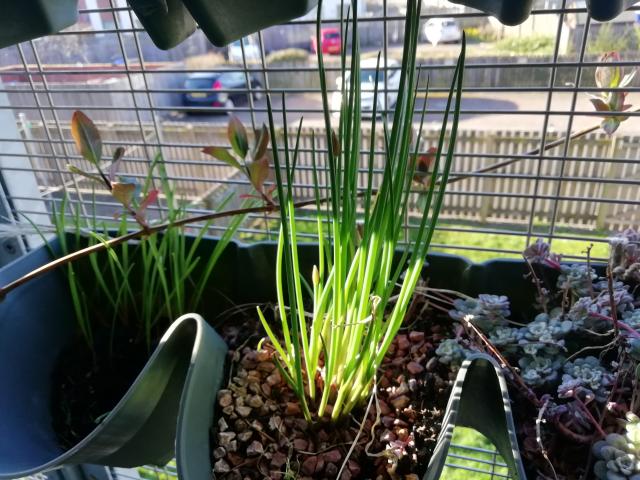
The top rail of the balcony is flat, and only about 10cm wide – another new challenge! To plant on it, I bought smaller planters and put small holes in the bottom. Through those holes I threaded the garden twine, and tied them tightly to the rail so they couldn’t fall off. I lined the bottom of these planters with garden fleece to prevent any compost running out when they are watered, and have planted them with more alpine and coastal plants including native Bird’s-foot Trefoil, Thrift (Armeria) and Sea Campion (Silene maritima), and the common rock-garden plant Aubrieta. I’m also growing annual plants like Viper’s Bugloss (Echium) for this layer – this plant is found in the wild on coasts and exposed hillsides with very poor soil, so it should do well here. Bumblebees love the pollen and nectar produced by this plant so I can’t wait to see how many bees it brings.
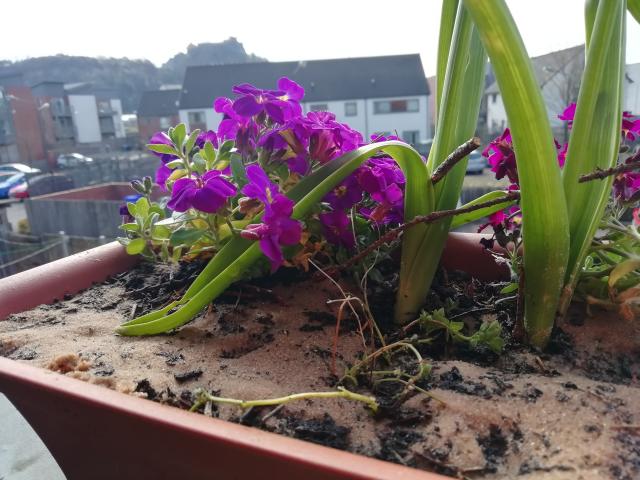
I’ve covered the surface of the compost with fine sand to reduce the amount of water that evaporates from it, as dark compost will absorb a lot of heat from the sun, whereas the light-coloured sand reflects the heat.
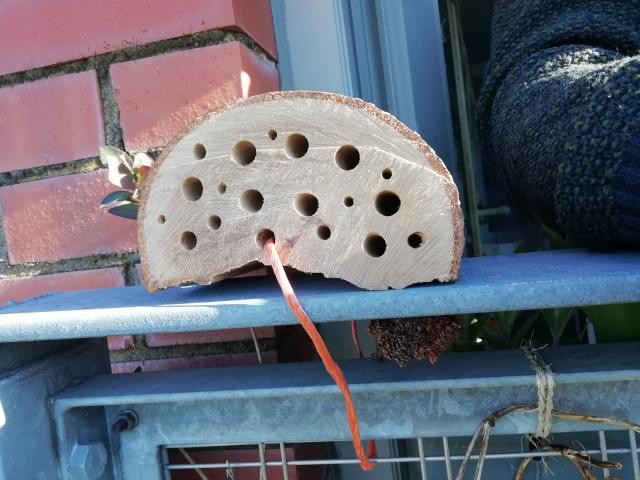
I’ve also been adding nests for solitary bees which I’ve made myself from offcuts of fallen branches. I simply drilled holes of varying sizes into them, but holes that are 8 or 10mm are best for the bees that have already taken up residence – the Red Mason bee! Within a week of these being put out I found evidence of the bees nesting. Red Mason bees are a species of solitary bee, and the females construct compartments made of mud inside the cavities of the nest. Inside each chamber she lays a single egg and leaves a mass of pollen for her future offspring to consume. She then abandons the nest and her young will feed up on the pollen and emerge the following year.
To secure these to the railing I just drilled one hole going diagonally through the wood so that it emerged half way along the lower half, and I threaded the extra strong garden twine through this hole and tied the whole thing to the rail.
I’ve been truly at amazed at how quickly insects find the flowers in this area, but really I shouldn’t have doubted them. All of this is just to say that whatever kind of space you have access to, you can always find ways to make it better for insects. Plants grow in an enormous range of conditions around the world, and we need to draw inspiration from those plants to create wildlife havens wherever we can.
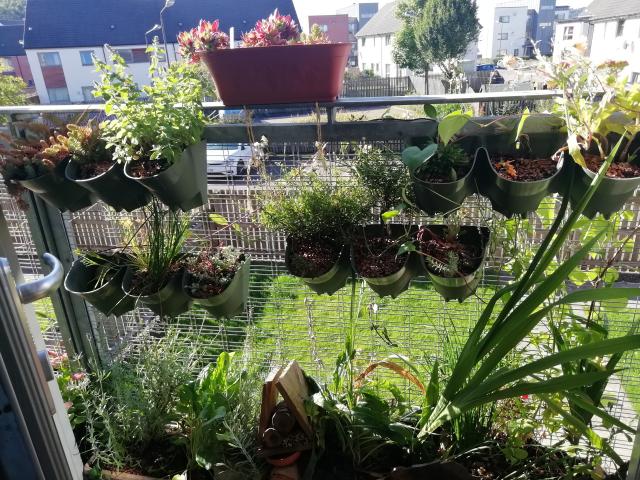
The Secret Gardener


